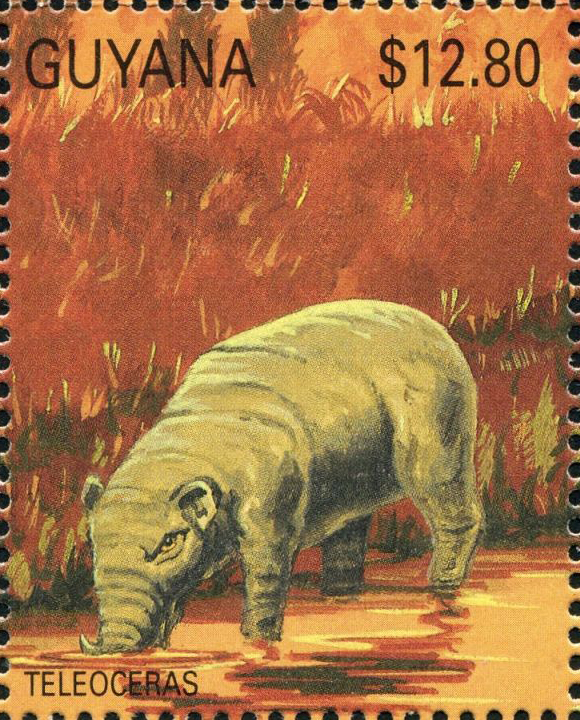Teleoceras sp.

(Da: en.wikipedia.org)
Phylum: Chordata Haeckel, 1874
Subphylum: Vertebrata Cuvier, 1812
Classe: Mammalia Linnaeus, 1758
Ordine: Perissodactyla Owen, 1848
Famiglia: Rhinocerotidae Gray, 1820
Genere: Teleoceras Hatcher, 1894
Specie e sottospecie
Il genere annovera attualmente le seguenti specie: Teleoceras aepysoma Short, Wallace & Emmert, 2019 - Teleoceras americanum Yatkola & Tanner, 1979 - Teleoceras brachyrhinum Prothero, 2005 - Teleoceras fossiger Cope, 1878 - Teleoceras guymonense Prothero, 2005 - Teleoceras hicksi Cook, 1927 - Teleoceras major Hatcher, 1894 - Teleoceras medicornutum Osborn, 1904 - Teleoceras meridianum Leidy, 1865 - Teleoceras proterum Leidy, 1885.
Descrizione
Questo animale, pur essendo strettamente imparentato con i moderni rinoceronti, aveva un aspetto molto simile a quello di un ippopotamo, e di quest'ultimo probabilmente rispecchiava anche le abitudini di vita. Le zampe erano cortissime e molto robuste, adatte a sorreggere un corpo eccezionalmente lungo e voluminoso. La testa era probabilmente dotata di un piccolo corno posto sopra le narici. Senza dubbio il teleocerato frequentava le rive dei fiumi e dei laghi del Nordamerica (numerosi resti fossili sono stati trovati nel parco dell'Ashfall Fossil Beds nel Nebraska), passando gran parte del suo tempo in acqua. La specie più conosciuta è Teleoceras fossiger. Il teleocerato fa parte di un gruppo di rinoceronti piuttosto diffuso nel Miocene e nel Pliocene; una forma europea e asiatica simile a Teleoceras è Brachypotherium, i cui resti fossili sono stati rinvenuti anche in Italia.
Diffusione
Rinoceronte estinto, fossile del Miocene superiore e del Pliocene inferiore, vissuto in Nordamerica.
Sinonimi
= Mesoceras (Cook, 1930) = Paraphelops Lane, 1927.
Bibliografia
–Henry Fairfield Osborn: A complete skeleton of Teleoceras fossiger. Notes on growth and sexual characters of this species. Bulletin American Museum of Natural History 10, 1898, S. 51-59.
–Michael R. Voorhies, Joseph R. Thomasson: Fossil grass anthoecia within miocene rhinoceros skeletons: diet in an extinct species. Science 206 (Oct 19), 1979, S. 331-333.
–Rachel A. Short, Steven C. Wallace und Laura G. Emmert: A new species of Teleoceras (Mammalia, Rhinocerotidae) from the late Hemphillian of Tennessee. Bulletin of the Florida Museum of Natural History 56 (5), 2019, S. 183-260.
–Harold J. Cook: A new rhinoceros of the genus Teleoceras from Colorado. Proceedings of the Denver Museum of Natural History 7 (1), 1927, S. 1-5.
–Spencer George Lucas: The rhinoceras Teleoceras from the miocene of Jalisco, Mexico. New Mexico Museum of Natural History and Science Bulletin 44, 2008, S. 65-70.
–Lloyd G. Tanner: Stratigraphic occurrences of Teleoceras with a new kimballian species from Nebraska. Bulletin University Nebraska State Museum (10) 1 (Feb), 1975, S. 23-33.
–Gerardo Carbot-Chanona: Teleoceras y cf. Peraceras (Perissodactyla, Rhinocerotidae) en el Mioceno Tardío de Chiapas, Mexico. Lum 2 (1), 2021, S. 18-29.
–Ashfall Fossil Beds State Historical Park. Designated a national natural landmark.
–Robert Diffendal, Jr., Roger K. Pabian und J. R. Thomasson: Geologic History of Ash Hollow State Historical Park, Nebraska. University of Nebraska, Lincoln, 1996.
–Donald R. Prothero: The evolution of North American rhinoceroses. Cambridge University Press, 2005, S. 1-219.
–Alfred J. Mead: Sexual dimorphism and paleoecology in Teleoceras, a North American Miocene rhinoceros.Paleobiology, 26 (4), 2000, S. 689-706.
–Matthew C. Mihlbachler: Linking sexual dimorphism and sociality in rhinoceroses: insights from Teleoceras proterum and Aphelops malacorhinus from the late miocene of Florida. Bulletin of the Florida Museum of Natural History 45 (4), 2005, S. 495-520.
–Matthew C. Mihlbachler: Demography of late Miocene rhinoceroses (Teleoceras proterum and Aphelops malacorhinus) from Florida: linking mortality and sociality in fossil assemblages. Paleobiology, 29 (3), 2003, S. 412-428.
–Alfred J. Mead: Enamel hypoplasia in Miocene Rhinoceroses (Teleoceras) from Nebraska: Evidence of severe physiological stress. Journal of Vertebrate Paleontology 19 (2), 1999, S. 391-397.
–Xiao-Kang Lu, Tao Deng und Luca Pandolfi: Reconstructing the phylogeny of the hornless rhinoceros Aceratheriinae. Frontiers in Ecology and Evolution 11, 2023, S. 1005126.
–Kurt Heissig und Oldrich Fejfar: Die fossilen Nashörner (Mammalia, Rhinocerotidae) aus dem Untermiozän von Tuchorice in Nordwestböhmen. Sborník Národního Muzea v Praze – Acta Musei Nationalis Pragae (series B, Natural History) 63 (1), 2007, S. 19-64.
–Kurt Heissig: Family Rhinocerotidae. In: Gertrud E. Rössner und Kurt Heissig: The Miocene land mammals of Europe. München, 1999, S. 175-
–188.
–John Bell Hatcher: A median horned rhinoceros from the Loup fork beds of Nebraska. The American Geologist 13 (3) (March), 1894, S. 149-150.
–Esperanza Cerdeño: Diversity and evolutionary trends of the family Rhinocerotidae (Perissodactyla). Palaeo 141, 1998, S. 13-34.
–Donald R. Prothero, Claude Guérin und Earl Manning: The history of Rhinocerotoidea. In: Donald R. Prothero und R. M. Schoch (Hrsg.): The evolution of the Perissodactyls. New-York, 1989, S. 321-340.
–Bian Wang und Ross Secord: Paleoecology of Aphelops and Teleoceras (Rhinocerotidae) through an interval of changing climate and vegetation in the Neogene of the Great Plains, central United States. Palaeogeography, Palaeoclimatology, Palaeoecology 542, 2020, S. 109411.

|
Data: 06/11/1990
Emissione: La natura nel Cenozoico Stato: Guyana Nota: Emesso in un foglietto di 20 v. diversi |
|---|